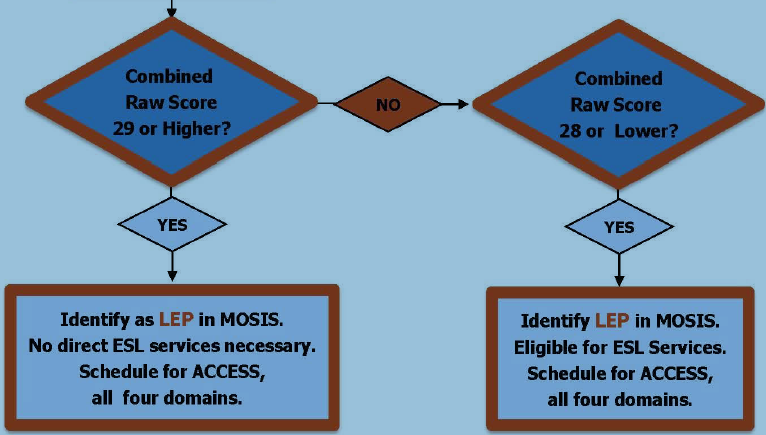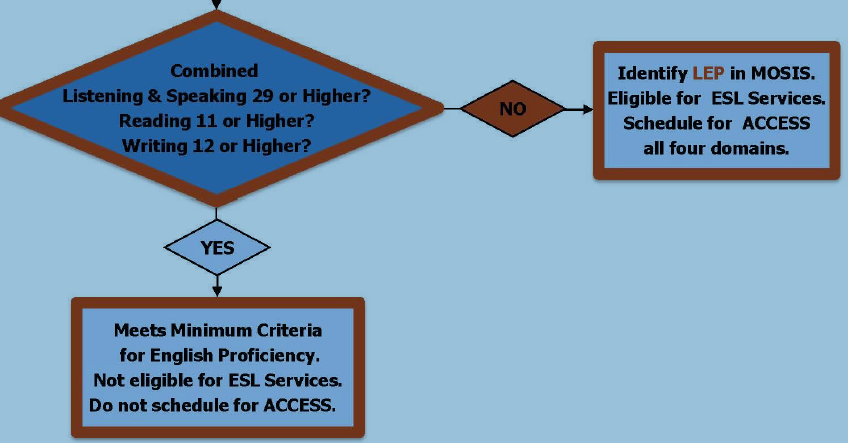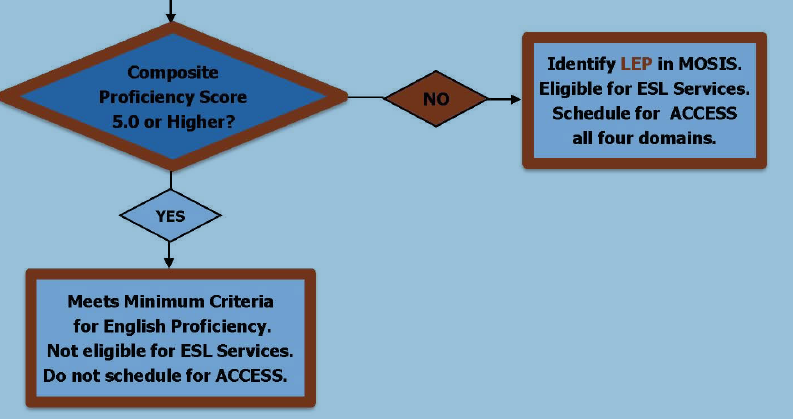

It is the policy of the Carthage R-IX School District to provide equitable access for Limited English Proficient (“LEP”) students, referred to throughout this document as English Language Learners (ELL). English as a Second Language instruction, referred to from here on as ELL instruction will be provided for all students of limited English proficiency who qualify according to established District guidelines and as judged by the Language Assessment Committee. The legal basis for the program is the landmark U.S. Supreme Court decision, Lau vs. Nichols, 414 U.S. 563 (1974) and the Equal Educational Opportunities Act of 1974. The U.S. Supreme Court stated that school districts must take action to ensure that limited English proficient students are able to benefit from an education conducted in English. More specifically, the Lau decision states that a school district will:
LANGUAGE ASSESSMENT COMMITTEE (“LAC”)
A Building LAC will be created at each school to coordinate and oversee the educational program of ELL students enrolled in the Carthage R-IX School District. It is the responsibility of the LAC to advise, identify, serve, assess, and eventually exit an ELL student from the language support system. The LAC will be composed of the principal, the guidance counselor, classroom teacher(s), parents when appropriate, an ELL teacher, and other ELL consultants on an as needed basis. The LAC meetings will be scheduled and conducted by the building principal or her/his designee. Committee membership will be individualized for each student and will change from meeting to meeting or year to year as appropriate.
The Building LAC responsibilities will include the following:
Appropriate members of the LAC and additional educational professionals will meet at the end of the school year to determine classroom placement and services needed for the next school year; at the entry of a new ELL; and/or at the request of any member. Data collection is key to effective evaluation and as such is the responsibility of the LAC.
A District LAC will be created and will consist of the ELL Coordinator, the Director of Special Services, the Assistant Superintendent for Instruction, and representatives from the following areas: Early Childhood, Speech and Language, Gifted and Talented, ELL, building level administration, and process coordination. The District LAC responsibilities will include monitoring, communicating, and revising (when needed) the processes for identification of ELL students for any special program or service.
IDENTIFICATION OF LIMITED ENGLISH PROFICIENT STUDENTS
A. The Carthage R-IX School District will identify the home languages of the student and his/her family with the state required Student Home Language Survey (HLS), to be filled out as part of an enrolling student’s registration. Parents who have Spanish as a native language and would like an interpreter may request one to assist them with the enrollment process.
GRADE LEVEL PLACEMENT AND RETENTION
Under no circumstances should the ELL student be placed in a grade level that is more than one year below his/her chronological age. The District will provide a structured language support program that meets the ELL as well as content area and equal access needs of the student. The LAC will ensure that ELL students will not be retained solely based on limited English proficiency. If a student’s academic difficulties are due to limited English proficiency, retention should not be considered.
ASSESSMENT OF ENGLISH LANGUAGE PROFICIENCY AND ACADEMIC SKILLS
Possible Limited English Proficient (ELL) students will be assessed for level of English language proficiency using the WIDA W-APT Screening assessment. W-APT stands for the WIDA-ACCESS Placement Test. It is an English language proficiency “screener” test given to incoming students to assist educators with placement decisions such as identification and services for ELLs. The test items include language from the five proficiency standards, so they cover academic language from the content areas. It also assesses all four language domains: listening, speaking, reading, and writing.
A. For those students who indicate on the Student Home Language Survey form that English is not their first language and/or another language is spoken in the home:
B. Criteria for Identification of ELLs: (noted here as LEP by the state definition)
1st Semester of Kindergarten

2nd Semester Kindergarten and 1st Semester of Grade 1

2nd Semester Grade 1 – Grade 12

C. Identification of students currently enrolled but not receiving services. If a student who is enrolled and has not been previously identified as ELL, but it is suspected that a student’s achievement is affected by limited English proficiency factors, or if evidence of another language in the home has been found, action should be taken to determine the student’s English language proficiency. The same steps are followed for assessment and identification of a new student.
D. Services to increase English proficiency/parent notification and legal rights. Once a student meets the criteria to receive services, parents are provided with a Parent Notification Form (Form 6180.2), which includes assessment results, eligibility information, program information and types of services. Parent(s)/guardian(s) of newly enrolled students will receive the parent notification of services within two weeks (10 school days) of enrollment, or 30 school days if the student enrolled prior to the first day of the school year. As stated above, this is the responsibility of the ELL teacher.
Chart of Student Proficiency Levels to Be Used in Determining Instructional Program
|
|
Relevant ACCESS Score |
Education History |
Special Services |
|
Level 1 |
1-1.9 Comprehension |
Age Appropriate |
None; G/T; Articulation |
|
Level 1S |
1-1.9 Comprehension |
SIFE* |
None; G/T; Articulation |
|
Level 1I |
1-1.9 Comprehension |
Age Appropriate |
Other IEP |
|
Level 2 |
2-2.9 Comprehension |
Age Appropriate |
None; G/T; Articulation |
|
Level 2S |
2-2.9 Comprehension |
SIFE* |
None; G/T; Articulation |
|
Level 2I |
2-2.9 Comprehension |
Age Appropriate |
Other IEP |
|
Level 3 |
3-3.9 Comprehension |
Age Appropriate |
None; G/T; Articulation |
|
Level 3S |
3-3.9 Comprehension |
SIFE* |
None; G/T; Articulation |
|
Level 3I |
3-3.9 Comprehension |
Age Appropriate |
Other IEP |
|
Level 4 |
4-4.9 Comprehension |
Age Appropriate |
None; G/T; Articulation |
|
Level 4S |
4-4.9 Comprehension |
SIFE* |
None; G/T; Articulation |
|
Level 4I |
4-4.9 Comprehension |
Age Appropriate |
Other IEP |
|
Level 5 |
5-5.9 |
|
|
|
Level 6 |
6 Comprehension |
|
|
*SIFE (Students with Interrupted Formal Education) are generally students in grades 5-12 who have missed 2 or more years of education for their chronological age)
PROGRAM DESIGN
The Carthage School District has selected English as a Second Language as its primary educational approach to educating ELL students. This model is a research-based model approved by the Missouri Department of Elementary and Secondary Education. The District supports simultaneous language and content development with built-in supports for students and professional development for teachers.
A. Educational Goals
INSTRUCTIONAL SERVICES
A. Programs to be used by the Carthage R-IX School District may include:
B. Process for determining the appropriate instructional service (LAC and ELL teacher/coach work together).
SPECIAL NEEDS PLACEMENT
A. Determining the special needs placement for students who are receiving ELL services is a complex process.There may be a number of individual or combined factors determining why language and cultural minority students are achieving little academic progress over time;the normal process of second language acquisition, the acculturation process, different learning styles, motivation to learn, or the student’s lack of prior schooling are a number of potential factors instead of intrinsic learning problems.Screening and diagnosing at-risk students receiving ELL services include a number of pre-referral steps to determine whether there exist temporary learning and behavior characteristics shared by learning disabled students and students of English as a second language, or whether referral to special education is warranted.The ELL teacher must be involved throughout the process.
The following pre-referral process will be followed to determine the necessity for referral to special education:
B. All ELL students who qualify for special needs placement may receive both special education services and supplemental English development services according to the student’s Individualized Education Plan (IEP).
C. All assessments for students who are identified as “home language other than English” will be administered in a form or language that will produce valid results.
D. Parents/guardians will be provided, to the extent practicable, information regarding testing results and placement decisions in a form or language they can understand.
SPECIAL OPPORTUNITY PROGRAMS
All ELL students shall have equal access to “Gifted and Talented” and “Advanced Placement” programs. The District LAC will establish and monitor procedures for the identification of ELL students for the Gifted and Talented program.
EXTRACURRICULAR ACTIVITIES
All LEP students shall have equal opportunity to participate in extracurricular and nonacademic activities.
COORDINATION OF SERVICES
The following procedures are in place to ensure communication and interaction among providers of service for ELL students:
EXIT AND RECLASSIFICATION CRITERIA
The Building LAC should gather data and review student records in order to make recommendations for students to be reclassified or continue progression on monitor status, or be removed from monitor status. This information should be collected by June 1 of each year and compiled on the recommended forms, placed in the student’s ELL file, and given to the ELL Coordinator.
A. Reclassification/exit: A student may be reclassified or exited according to these guidelines presented by the Missouri Department of Elementary and Secondary Education (DESE):
B. Students that meet the criteria of reclassification should be moved from Limited English Proficient (LEP) to Monitored Year 1 (MY1) in the student information system.
LAC members will follow-up on the placement impact (for those students who are reclassified or exited) each semester for two (2) calendar years following reclassification. The District ELL student monitoring data includes: course grades, writing competency, teacher observation of comparison to peers in classroom performance, reading level, level of accommodations/modifications needed or used in the classroom and teacher recommendations for need of ELL services.
The monitoring for the two-year period may be done via e-mail, conferencing with appropriate teacher(s), and other viable methods of communication. The LAC will convene at the end of the two-year period to determine if the student can be fully removed from Monitor status and classified as Fluent English Proficient. The committee may decide that the lack of academic progress is due to a need for language support and return the student to the language support program/reclassify as ELL.
STAFFING
A. ELL Teacher Requirements
As with other instructional personnel, ELL staff must be qualified with academic preparation in English as a Second Language as stipulated in the 1991 Office of Civil Rights Memorandum. Evidence of ELL teachers’ fluency in English is necessary to engage qualified personnel. Typically, ELL support services that do not supplant the standard ELL curriculum may be provided by an education aide who is supervised by an ELL teacher in collaboration with the student’s regular classroom teacher(s).
The ELL teacher(s) must:
B. The District ELL Coordinator and the Assistant Superintendent for Instruction will monitor the number of ELL students and staff and maintain an appropriate number and quality of staff to support the instructional design and programs the District offers.
STAFF DEVELOPMENT
Given that all ELL students will spend a part of their instructional day in a regular content classroom, the District has developed a professional development institute that will gradually train all staff in ELL strategies which promote the acquisition of English and growth in core content subject areas. The institute’s training will combine SIOP (Structured Immersion Observation Protocol) and WIDA’s standards and assessment-based instruction to provide a solid research base to the professional development.
RESOURCES AND EQUITY
The District will conduct a review of the current curricular materials and the need for materials for the ELL program on a rotating tri-annual schedule that falls in conjunction with its review of all English Language Arts curricular materials. The same procedures set forth for all content areas apply to the ELL Department.
RECORD KEEEPING/THE LANGUAGE PROCESS FILE
The LAC will maintain the Language Progress File (LPF) which is a green folder kept inside the student’s cumulative file, consisting of:
STATE TESTING
If allowable by the test administration guidelines, the LAC may set up accommodations for students who have difficulty taking standardized achievement tests, or if the student has difficulty competing with monolingual English-speaking peers. However, this only applies to students who are still considered ELL, not students who are being monitored or who have been fully transitioned to Fluent English Proficient status.
PARENT INVOLVEMENT
All parents of students who are speakers of other languages will be given equal opportunity and encouragement to participate in the education of their children by providing, to the extent practicable, information in a language they can understand.
Parents will be provided timely notification when activities are planned. These notifications may be in the form of notes in a language they can understand, by phone calls also in a language they can understand, or by other practical methods to the extent possible.
Activities for parents include, but are not limited to: Family nights, conferences, art shows, Title I events, Hispanic parent nights, Latino Family Literacy, Dual Language Academy community nights, college campus visits and presentations.
WORKING WITH PRIVATE SCHOOLS
The District will consult and coordinate with private schools in a timely manner for equitable service delivery. Delivery of ELL services must be at a public school or a neutral site. They cannot be at the private school location.
PROGRAM EVALUATION
Representatives from each building’s Language Assessment Committee (LAC) will evaluate ELL services and maintain recordkeeping procedures.
The ELL program will be evaluated annually by this representative committee to determine the program’s effectiveness. Adjustments will be made to the program as needed. The annual program evaluation will include, but not be limited to:
This committee will also bring recommendations from their respective building committee on needed revisions to the District’s LAU plan, to be approved by this representative committee and be presented to the assistant superintendent for review and further approval.
PROGRAM FAILURE NOTIFICATION
The District must notify parents when the program is failing to ensure language proficiency (when not meeting the Annual Measureable Achievement Objectives (AMAOs).
ADDITIONAL RATIONALE FOR THE CARTHAGE R-IX LAU PLAN
Federal Legislation:
Court Decisions:
State Requirements:
CARTHAGE R-IX SCHOOL DISTRICT ELL COORDINATOR
The Board of Education has appointed a 1.0 FTE ELL Coordinator of programs for English Language Learner (ELL) students.